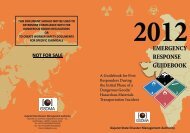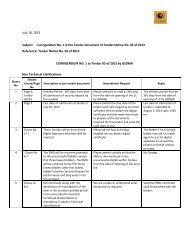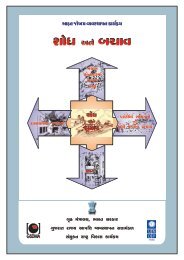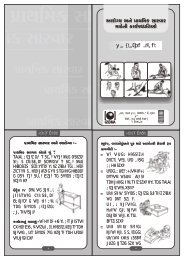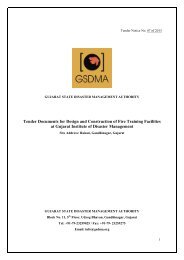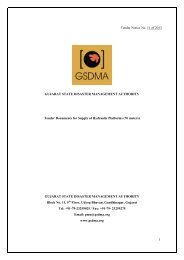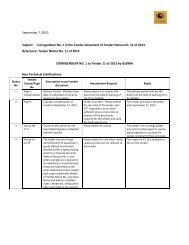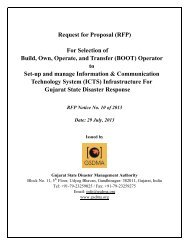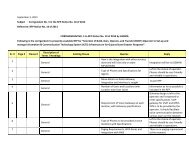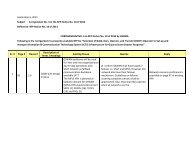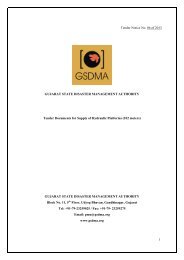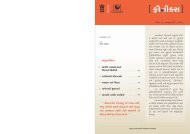GUJARAT STATE CHEMICAL DISASTER MANAGEMENT PLAN
GUJARAT STATE CHEMICAL DISASTER MANAGEMENT PLAN
GUJARAT STATE CHEMICAL DISASTER MANAGEMENT PLAN
- No tags were found...
You also want an ePaper? Increase the reach of your titles
YUMPU automatically turns print PDFs into web optimized ePapers that Google loves.
1INTRODUCTION1.3 APPROACH TO PREPARATION OF <strong>STATE</strong>CDMPThe international consultant team appointed by GSDMAhas prepared the CDMP in a participatory and modularapproach. The following reports developed as a partof preparatory modules under the contract with GSDMAprovide the basis for the State CDMP:Module 11. Capability assessment and gap analysis2. Vulnerability assessment3. Antidotes plan4. Synchronization between onsite and offsite plansModule 21. Improvement in response mechanism2. Community sensitization strategy3. Performance improvement of DISH, PESO and CEI4. GIS based database system for chemical disastermanagementAll these interim reports were prepared in participatorymanner by inclusion of all key stakeholders and providemuch more in-depth information than that summarized inthis state CDMP. The purpose of state CDMP is not to providea page heavy report by consolidating all information butto provide a “plan” that will help us identify what must bedone to achieve high level of preparedness and capability.The required information for preparing the reports wascollected from secondary data provided by variousagencies, one-on-one interviews, group interviews,workshops, and organizational assessments by experts.In addition, the study team has built upon the StateChemical Emergency Response Plan prepared by the StateCrisis Group in 2008. The study team has also consideredNDMA guidelines in preparation of the plan. This CDMPis not an attempt to replace the available state responseplan that is based on current realities, but it is a plan toachieve international levels of preparedness consideringthe existing administrative and legal set up in India. Therecommendations here in range from easy short termsolutions to complex longer term strategies. This CDMPwas discussed with all stakeholders and their commentswere incorporated1.4 DIFFERENCE AND SYNERGIES BETWEENCDMP AND OFFSITE <strong>PLAN</strong>SMOEF took the leadership in setting up legal andinstitutional framework for managing chemicalemergencies in industries through MSIHC Rules (1989)and CEAPPR Rules (1996) for more than two decadesfollowing the Bhopal Tragedy. One of the instrumentsfor chemical management is offsite emergency planby DCG and SCG. It is highly credible that MOEF hasbeen effective in making such plans based on realitieson the ground. However, the DM Act (2005) and GSDMAct (2003) were the paradigm shift in management ofdisasters in the country, including chemical disasters.DM Act (2005) and GSDM Act (2003) envision “AllHazard” concept to disaster management. These actsalso mandated creation of state and district (andlocal) disaster management authorities. In some ways,this created a parallel structure to manage chemicalemergencies, but in other ways these authorities orthe crisis groups under MSIHC are not the responseagencies themselves.Therefore, the responsibilityfor response is still with individual departments. DMActs also required preparation of DMP that consider theentire cycle of Prevention and Mitigation, Preparedness,Response, Recovery and Rehabilitation. On other hand,offsite plan under MSIHC Rules focus on response tochemical emergencies and preparedness to provide suchresponse. The offsite plan thus included information thatmust be readily available during response to a chemicalemergency, but offsite plans do not provide a “plan” totake a comprehensive approach to disaster management.While, nothing in MSIHC Rules stops the offsite frombeing developed in to a comprehensive plan for disastermanagement, the fact is that the newer DM Act usethe term DMP to distinguish itself from Offsite Plan.As demonstrated in Figure 1 below, ideally an offsiteplan can be an element of a more comprehensive DMP.1.5 HIERARCHY AND RELATIONSHIP OF THE<strong>PLAN</strong>SMSIHC Rules 1989, CEAPPR Rules 1996, GSDM Act 2003,and DM Act 2005 recognize that disaster management isa participatory and bottom-up process. Therefore, all2 <strong>GUJARAT</strong> <strong>STATE</strong> INDUSTRIAL <strong>CHEMICAL</strong> <strong>DISASTER</strong> <strong>MANAGEMENT</strong> <strong>PLAN</strong>



